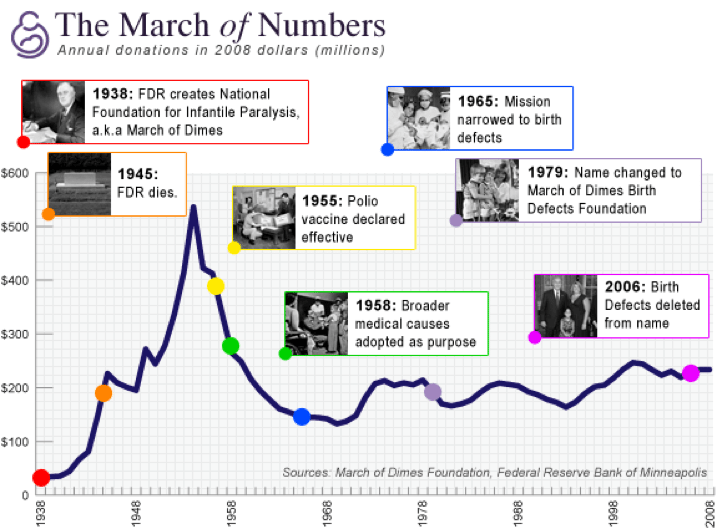
August 2, 2018; Science
For medical researchers in 37 laboratories, August did not start very well. At the end of July, with little warning, the March of Dimes, needing to reduce its $20 million annual research budget by $3 million, notified its grant-funded researchers that their multi-year grants would be cut short and they’d need to search for new funding. Worse, grantees were informed of this a month after funding had lapsed, leaving them presumably in deficit with no planning time. But the problem that the March of Dimes was addressing was or should have been evident to them for a while, since it was a part of a long-term trend of decline in its fundraising and asset base.
Kelle Moley, chief scientific officer for March of Dimes, explained to Science magazine that the decision to reduce funding was part of an ongoing effort to realign the organization’s operations. “It’s vital,” she says, “that we invest all of our resources into research programs that have the greatest potential to impact the biggest threat right now facing newborn babies, and that’s preterm birth.” According to Science, donations have declined, especially to March for Babies, whose walks were the group’s main funding source but cannot compete in a world with “a million different kinds of walks.”
“They’re just not getting the donations that we used to get 10 or 20 years ago,” Moley said.
A review of the March of Dimes’ tax returns shows the organization has been struggling for several years to bring their expenses in line with rapidly shrinking revenues. In 2011, the organization raised more than $200 million, and they were able to generate a small surplus. Five years later, in 2016, they raised only $163.5 million and had a deficit of $8.7 million, which was an improvement from 2015’s loss of more than $26 million.
Internally, the March of Dimes appears to have been trying to maintain an image of vitality in the face of a long-term decline. As NPQ noted last year, the March of Dimes has been in cost-cutting mode for some time now. A year ago, they put their suburban New York headquarters building up for sale and relocated their main office to Washington, DC, laid off 100 people and made cuts to their pension program.
Readers may remember that the March of Dimes has a long history, which included a mission switch when the polio vaccine was developed. This chart, which NPQ included in an article we wrote about March of Dimes last year, exhibits that rollercoaster revenue ride.

What appears to have been missed in the rush to cut costs is the need to engage key researcher stakeholders and keep them informed of what might become necessary. The March of Dimes’ message to those losing funding, as reported by Science, reflected its focus on planning but didn’t recognize its impact on those affected.
Sign up for our free newsletters
Subscribe to NPQ's newsletters to have our top stories delivered directly to your inbox.
By signing up, you agree to our privacy policy and terms of use, and to receive messages from NPQ and our partners.
The message to grantees…said the organization has, since the start of this year, been “transforming and modernizing its operation to ensure the long-term viability and impact of the organization” and that its research grant program was “being reviewed and modernized to ensure it is aligned with the organization’s broader transformation.”
Marc Kastner, president of the Science Philanthropy Alliance told the Baltimore Sun that “it is uncommon for a nonprofit organization to cancel grants so abruptly. I have never heard of a case where commitments are not fulfilled. To get scientists working on a project and then cut them off is wasteful and creates enormous hardship.”
The researchers whose work is now threatened must now scramble with little warning for funding or terminate their projects. According to Science, chromosome biologist Andreas Hochwagen “was startled to learn last week that the organization would only disperse 2018 funding owed through the end of June. ‘For the whole month of July, they didn’t tell me that I wasn’t being supported anymore…that I find a little outrageous.’” Molecular cell biologist Andrew Holland of Johns Hopkins University School told Science that “the way they’ve approached this has been completely inhumane…the lack of transparency has been nothing short of appalling.”
To add insult to injury, Nature reports that:
Researchers also say that the March of Dimes is months behind on tens of thousands of dollars in grant payments stretching back to late 2017. In many cases, scientists were unaware of the late payments until their grants were cancelled.
Moley says the late payments are due to the March of Dimes’ unpredictable cash flow, and notes that the group’s grant policies state that awards can be cancelled at any time. “Even though researchers are upset and disappointed,” she adds, “I hope they will continue to believe in us—we believe in them.”
But Holland says that he will not apply again for a March of Dimes grant. “One week of notice is inhumane,” he says. “I didn’t know this was possible until it happened.”
Would giving their grantees an earlier warning of the potential for funding cuts have been too great a risk for the March of Dimes to take? While the cash savings of immediately ending funding is clear, would it have not been better to provide a longer period of grant “severance” so that research could continue, and researchers had time to marshal other resources to their work? For an organization that wishes to continues to “pioneer research to find solutions to the biggest health threats to moms and babies,” should not their reputation and relationships within the research community that will find those solutions be of greater value?—Martin Levine













